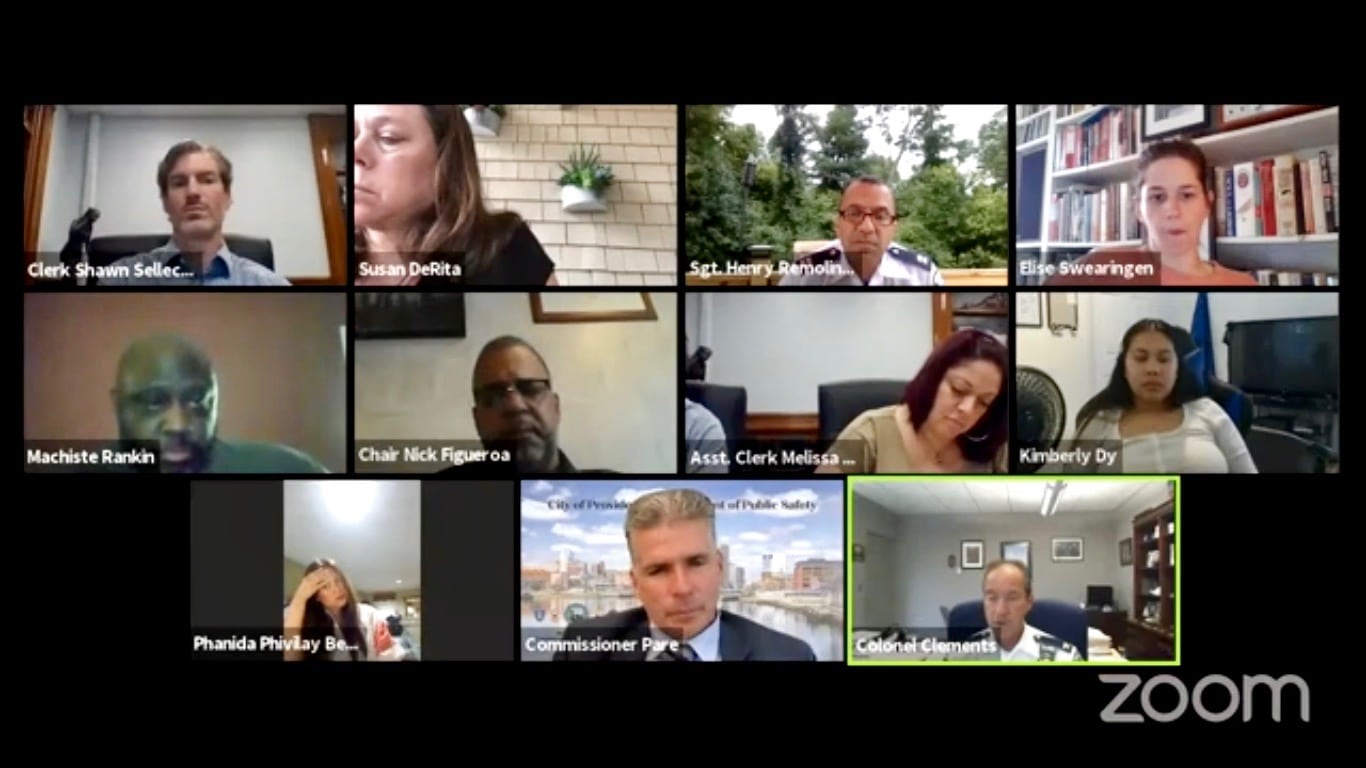Providence’s civilian oversight board blocked by police from accessing body camera footage
A debate over body camera footage at PERA’s monthly meeting shows that relying on the police department to cooperate with independent investigations may be a flawed strategy. The Providence Police Department is refusing to give body camera footage of Sgt. Joseph Hanley’s alleged assault of a handcuffed man to the Providence External Review Authority (PERA), the civilian oversight board tasked
July 9, 2020, 9:21 am
By Julia Rock
A debate over body camera footage at PERA’s monthly meeting shows that relying on the police department to cooperate with independent investigations may be a flawed strategy.
The Providence Police Department is refusing to give body camera footage of Sgt. Joseph Hanley’s alleged assault of a handcuffed man to the Providence External Review Authority (PERA), the civilian oversight board tasked with investigating police misconduct.
Providence Public Safety Commissioner Steven Paré attended PERA’s monthly meeting last night to speak with the board about the Police Department’s investigation into Sgt. Hanley.
In May, Hanley struck Black 28-year-old Rishod Gore several times while Gore was handcuffed. Hanley has been suspended with pay while the Police Department conducts an internal investigation of the incident, which could take months.
Hanley was also charged with misdemeanor simple assault. Mayor Jorge Elorza has recommended that Hanley be fired.
In June, PERA invoked its statutory authority to conduct an independent review of the Police Department’s investigation into Hanley. (This is different from other investigations that PERA has already undertaken, in response to complaints from civilians directly to the board. PERA has not made any recommendations on such investigations to date.)
The main topic of Wednesday’s PERA meeting was the footage from Hanley’s body camera that was captured during the assault. The footage was shown to the police’s internal advisory board, which is composed of 20-25 civilians according to Paré, after the assault. But when PERA later asked for the footage, the Police Department denied the request.
During the meeting, Paré gave two reasons for his denial. First, he said that since the footage is part of an ongoing criminal investigation, it qualifies as evidence that cannot be publicly released without compromising the investigation. (Paré said that the police advisory board was shown the video before the criminal investigation was opened). Second, he said that the Law Enforcement Officer Bill of Rights prevents the department from releasing the video while an internal investigation is ongoing.
Whether these two arguments had any legal basis was up for debate.
Jose Batista, the executive director of PERA, said that the oversight board has the statutory authority to conduct independent investigations, and therefore should have access to the video.
In addition to the video, Batista also said that he and PERA investigator Eugene Monteiro had not been properly briefed on the Hanley case. Paré said that if they had not been briefed, he would give them a verbal briefing but would not be able to share any documents.
Batista and the civilian members of PERA expressed frustration at the Police Department’s refusal to hand over the video. But, as Batista said himself during the meeting, the discussion was about something bigger than the Hanley investigation. It was about the past 18 months or so that PERA––and especially, Batista––has spent attempting to build a working relationship with the Police Department.
Regardless of whether Paré can share the video now, or the legal reasons he gave for withholding it stand, it remains true that as many as 25 civilians saw the body camera footage and PERA did not.
Furthermore, when Providence Youth Student Movement (PrYSM) activist Justice Gaines asked if Paré could commit to sharing such evidentiary material with PERA in the future, Paré said it would depend on the situation. When Elise Swearingen, a civilian member of PERA, asked whether Paré would act differently if the same situation happened again, Paré responded, “perhaps.”
Paré didn’t hide from the fact that PERA is relying on him to provide records for the investigation. He told PERA that the board can conduct investigations, only “as long as we can protect the process.”
Legally speaking, this isn’t true. Shannah Kurland, the lawyer for PrYSM, pointed out during the brief public comment period that it has been PERA’s choice to pursue cooperation in this investigation, and in its investigations of civilian complaints. She said that PERA could file a public records request to get the body camera footage, and let the Law Department decide whether to hand it over. If the Law Department denied the request, Kurland said, PERA could file an appeal or complaint with the Attorney General.
PERA could also ask the City Council to subpoena a copy of the video, which Batista previously told me he has chosen not to do in part because of the legal costs associated with going to court. (PERA’s budget is less than .5% of the Police Department budget.)
The meeting was an indictment of PERA’s cooperation strategy. To the extent that PERA is trying to conduct its own, independent investigations of police conduct, it is doing so by pursuing an amicable relationship with the Police Department.
Batista and PERA are now left to decide how they will seek out the body camera footage. PERA’s choice will be revealing. And it’s not just PERA––Elorza and most of the City Council have so far stayed silent, at least publicly, on the Police Department’s handling of PERA’s investigation into the Hanley case.
Here’s the video:
This piece is also over at A Little Rhody, Julia Rock‘s excellent, independent news service







